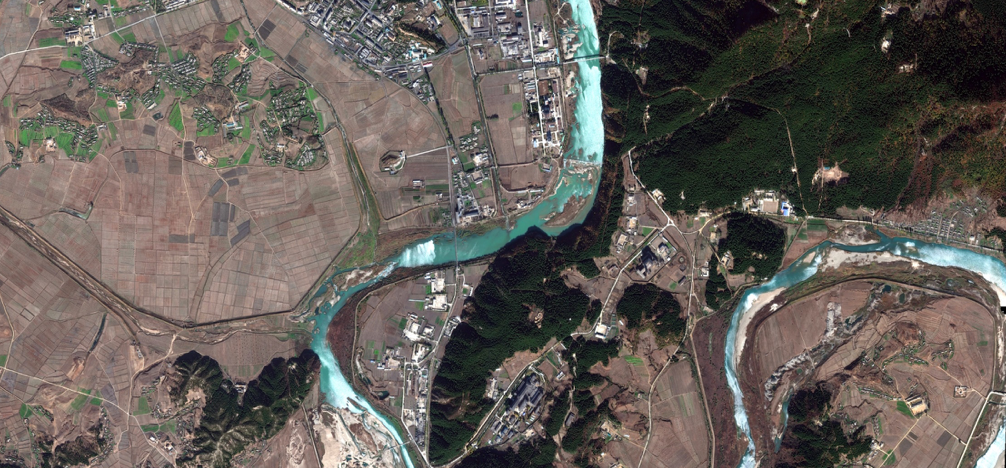
Yongbyon Update: November Movement of Radioactive Material?
Key Findings
- Recent satellite imagery from November 2019 shows the presence of four specialized railcars that have been associated with the movement of radioactive material in the past.
- The last observed movement of these railcars by Beyond Parallel was in April 2019.
- It is unclear whether the railcars are being used for the outbound shipment of irradiated liquid or solid waste, disassembled but contaminated equipment or the movement of fissile material to facilities outside the Yongbyon area. A less likely alternative is the inbound shipment of radioactive material from a facility outside the Yongbyon area.
- Given the current diplomatic stalemate in denuclearization talks between North Korea and the United States it is unclear if the presence of these railcars represents another carefully calibrated political maneuver by North Korea, the actual movement of radioactive materials or a combination of both.
- These findings underscore that the Yongbyon nuclear complex remains active in the absence of diplomatic breakthroughs following three meetings between Donald Trump and Kim Jong-un.

Satellite imagery of North Korea’s Yongbyon Nuclear Research Facility acquired on November 1st and November 9th show the presence of four specialized railcars that have been associated with the movement of radioactive material in the past. These four specialized railcars consist of two approximately 13-meter-long depressed-center railcars with four casks, one approximately 10-meter-long flatcar with four casks, and an approximately 10-meter-long railcar that appears to be a flatcar carrying what may be a shipping container, large crated piece of equipment or similar sized load.1
As with our report from April 15, 2019, a lone approximately 10-meter-long flatcar with four casks was positioned on the track to the west of the Radiochemistry Laboratory in the November 1st image while the remaining three railcars were located at the southern railyard serving the Uranium Enrichment Plant and reported Isotope/Tritium Production Facility. Eight days later, in the November 9th image, all four railcars have been moved to the nearby Pungang-ni rail station servicing the Yongbyon Nuclear Research Facility.

A 10-meter-long flatcar with four casks positioned on the track to the west of the Radiochemistry Laboratory on November 1, 2019. (Copyright © 2019 by Maxar Technologies) 
The 10-meter-long flatcar with four casks that was positioned on the track to the west of the Radiochemistry Laboratory has been moved as of November 9, 2019. (Copyright © 2019 by Airbus)

Three of the four railcars are seen in the railyard serving the Uranium Enrichment Plant and reported Isotope/Tritium Production Facility on November 1, 2019. (Copyright © 2019 by Maxar Technologies) 
Three of the four railcars that were in the railyard serving the Uranium Enrichment Plant and reported Isotope/Tritium Production Facility have been moved as of November 9, 2019. (Copyright © 2019 by Airbus)

No railcars are present at the Pungang-ni rail station servicing the Yongbyon Nuclear Research Facility on November 1, 2019. (Copyright © 2019 by Maxar Technologies) 
All four specialized railcars are present at the Pungang-ni rail station servicing the Yongbyon Nuclear Research Facility as of November 9, 2019. (Copyright © 2019 by Airbus)
While there is some preliminary analysis associating these four specialized railcars to reprocessing campaigns at the Radiochemistry Laboratory this does not appear to be true in all instances or in the current situation. Exactly what type of radioactive material is being transported by these specialized railcars is unclear. The relatively small size and number of casks on these specialized railcars suggests the outbound shipment of small quantities of irradiated liquid or solid waste, disassembled but contaminated equipment or, potentially, the movement of fissile material to facilities outside the Yongbyon area.2 An alternative, although apparently less likely, is the inbound shipment of radioactive material from a facility outside the Yongbyon area. The precise location of any such external facilities is unclear.
For many years, North Korea has repeatedly demonstrated an astute and remarkably effective skill of maneuvering international diplomatic tensions to its benefit through strategic escalation and de-escalation. Given the current diplomatic climate between North Korea and the United States it is unclear if the presence of these railcars represents another carefully calibrated move by North Korea to maneuver the U.S. into a favorable negotiating position, the actual movement of radioactive materials or a combination of both.
References
-
These lengths should be viewed as approximate since resolution of the imagery is insufficient to more accurate measurements.
Depressed-center railcars are typically used for moving large or heavy loads and are not common on North Korea’s rail system.
It should be noted that the fourth railcar also bears some resemblance to an old transfer caboose. However, a determination of its exact configuration is not possible at present due to limitations in resolution. ↩
- It has also been suggested that these specialized railcars are delivering chemicals to be used in various conversion processes. This is unlikely, as in North Korea bulk chemicals are delivered by rail tanks cars, tanker trucks or cargo trucks with drums. ↩
